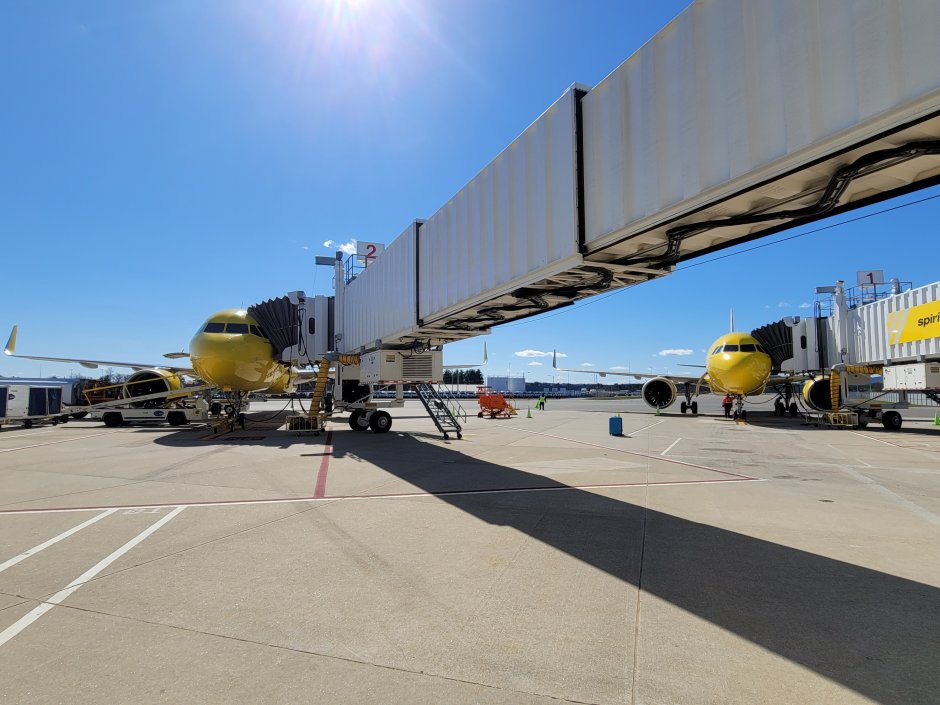
Florida-based Spirit Airlines became the first new airline at Manchester-Boston Regional Airport (MHT) in 17 years when it launched four routes from the New Hampshire airport last October.
The flights connected the airport, located about 54 mi. (87 km) away from Boston Logan (BOS) in Massachusetts, to Fort Lauderdale (FLL), Fort Myers (RSW), Orlando (MCO), and Tampa (TPA). Since then, the ULCC has added a fifth route to Myrtle Beach (MYR) in South Carolina to its network.
Routes caught up with MHT airport director Ted Kitchens to find out more about the effect of the new services and Manchester-Boston’s next route development targets.
What has the impact been at MHT since Spirit began operations last October?
The introduction of Spirit to the Manchester market has stimulated demand and helped reverse some of the historical leakage to surrounding airports. For example, on the MHT-RSW route our leakage has reduced from 89% in Q4 2019 to 72% in Q4 2021, while the one-way fare has reduced $178 to $126. Anecdotally, we are seeing more families and large groups using the service—and the airport in general—than we did prior to the start of service by Spirit.
What attracted Spirit to MHT? How have the routes performed so far?
This region is characterized by having a very well-compensated and very well-educated population. In fact, the per capita personal income for the southern New Hampshire region is in the top 10% of all areas of the country in 2020. High incomes generally have high levels of disposable income, and disposable income likes to travel! Thus, the region generates a tremendous amount of demand, but a lot of that demand is leaking to Boston-Logan due to fare imbalance. So, we had to get smart about who our customer is and, more importantly, who our customer was not.
Through our partnership with the University of New Hampshire, we started conducting quarterly pulse surveys showing that 70% of the population preferred to fly out of MHT and that lower fares would get them to choose MHT over BOS.
Additionally, the airport made several critical business decisions that helped jump-start the market, including restructuring our long-term debt to reduce airport rates and charges by 30%, creating and publishing our first Air Service Incentive Plan that heavily incentivized a new entrant carrier, and lastly, through our partnership with local chambers of commerce, the region created our first ever business consortium—the Air Service Support and Enhancement Team (or The ASSET)—to help further support air service efforts at the airport.
Together, The ASSET and the airport joined forces to apply for a Small Community Air Service Development Program (SCASDP) grant in hopes of providing additional marketing support for Spirit. We were awarded the grant and have been utilizing those funds to assist Spirit in building the market. We also enhanced our governmental relations on the state and national level.

Additionally, the catchment study we conducted with our air service consultant allowed us to truly quantify the passenger demand leaving our catchment area to use Boston or other airports to access markets Spirit was interested in serving. We were also able to illustrate to Spirit that when our passengers leave our catchment area for other airports, they are largely utilizing Spirit’s competitors, not Spirit. This information illustrated the unique market opportunity that MHT provided for Spirit.
Combine all this with our historical demand—Manchester was once carrying over 2.5 million enplanements in the early 2000s—and the fact that population, employment, per capita income, and gross regional product are all higher now than back in the 2000s, and Spirit saw a clear business case.
Overall, the routes are performing well. They did take a little time to build, as we are trying to change people’s ingrained behavior of driving to Boston, and we launched right before the omicron variant of COVID-19 surged. But as we moved into February and March, which is the time Florida looks pretty good for Granite Staters and other Northern New Englanders, things have really taken off.
We have seen Spirit increase the size of aircraft from A319s to A320s and the occasional A321, as well as adding additional flights on peak days. Spirit also announced an additional destination to Myrtle Beach that began on April 20.
Is there further untapped demand for ULCC service in your catchment? Has Spirit’s entry broadened your catchment?
Yes, and yes. Spirit has done a great job in reversing some of the leakage that we have seen in Florida, and we anticipate a similar result in Myrtle Beach. But we are still leaking 83% of our market to Boston and other airports. Our airport costs are significantly lower than Boston-Logan, so we believe with better costs and now proof that low-cost service brings our passengers back that we are an excellent fit for additional LCCs or ULCCs.

We have seen, in addition to recapture of our leakage, that Spirit’s service is bringing in passengers from bordering states at a better rate than the airport overall, and we think that phenomenon can continue as Spirit grows and other LCCs/ULCCs discover the market opportunity we have in MHT.
What are your next route development targets? Are you seeking to attract more point-to-point (P2P) routes from new/existing partners or increase hub connectivity?
A little bit of both. Clearly the ULCC model will be more P2P, and we have additional demand that could be recaptured. Boston-Logan will always play a role in the air service dynamic in New England, and we are cognizant of that fact; so, we are aiming more toward capturing some of the leakage. We feel that this airport could be, and considering our past, should be around 1.75 million enplanements, and this is achievable.
However, additional hub connectivity, particularly to the west, is critical. Over 25% of our O&D demand is heading to a location west of the Mississippi River—but when you look at our catchment area demand, that percentage increases to over 40% because passengers going west are leaking at a higher rate due to our lack of service.
So, connections to critical business centers like DFW, SAT, PHX, and IAH and to leisure destinations like LAS and DEN are on our list. The Denver market is an interesting story as there is a strong affinity between DEN and MHT. When MHT-DEN service existed in the early to mid-2000s, it performed well, with load factors routinely above 90%. We’ve got today nearly 150 people every day leaving our catchment area to fly to DEN from a different airport.
Spirit has proven that this demand can be returned to MHT with good low-cost service, and now, thanks to the 30% reduction in our costs from the debt restructuring, the airport can help carriers serve this demand and keep more of their revenue.
What’s the situation as we enter the summer season?
We are cautiously optimistic. We had a very strong summer last year with station load factors above 90%, so demand is clearly there. We just need additional capacity. The introduction of Spirit to the summer 2022 schedule clearly represents additional capacity that we did not have in summer 2021.
However, labor and fuel issues facing the industry may prevent us from realizing the full potential this market has to offer. Over the long-term though, we are well positioned to grow our air service at MHT.
